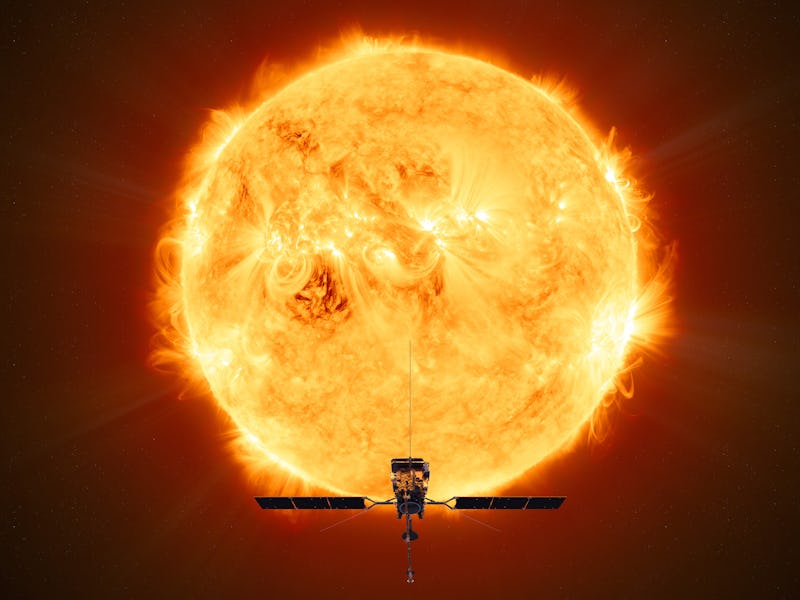This Solar Probe Just Helped To Trace The Origins Of Space Weather
ESA’s Solar Orbiter went nearly as close as Mercury to find out how and why solar winds form.

The European Space Agency’s Solar Orbiter recently shed some new light on what causes space weather.
The constantly-shifting lines of the Sun’s magnetic field do strange things to the super-heated plasma at the Sun’s surface, causing cool, dark patches called sunspots, dark areas with one-way magnetic lines called coronal holes, and high arcs of glowing plasma called prominences. Each of these features, it turns out, spawns different types of solar wind, which affects the rest of the Solar System. By connecting its measurements of solar wind in space with data about the surface features the wind came from, the Solar Orbiter helped show that these features produce different types of solar wind. This could help physicists predict space weather in the future.
Northumbria University physicist Stephanie Yardley and her colleagues published their work in the journal Nature Astronomy.
An artist’s illustration shows ESA’s Solar Orbiter taking aim at the Sun.
Staring At The Sun
ESA’s Solar Orbiter came within 47 million miles of the Sun in early March — about half the distance between the Sun and Earth, and nearly as close to the Sun as radiation-scorched Mercury. (For comparison, NASA’s Parker Solar Probe has swooped within 4 million miles of the Sun, flying through its wispy outer atmosphere, or corona.) From that vantage, instruments aboard the Solar Orbiter measured the properties of solar wind: the endless stream of electrically-charged gas blown outward from the Sun.
Yardley and her colleagues compared those measurements of the solar wind’s temperature, electrical charge, speed, and density to the Solar Orbiter’s high-resolution, close-up images of features on the Sun’s surface. The results helped confirm that what’s happening on the Sun’s surface — things like sunspots and coronal holes — really do spawn dramatic changes in the solar wind that eventually affects satellites in orbit around Earth.
Our Sun isn’t just a cozy space heater at the heart of our Solar System; it’s a huge, churning ball of turbulent thermonuclear fire with a restless, ever-shifting magnetic field. Where the Sun’s magnetic field passes through the electrically-charged gas, or plasma, roiling at the surface, it creates strange patterns; where magnetic field lines intersect and tangle, dark patches called sunspots form; in other places, lines from the magnetic field poke out into space instead of curving back down into the Sun, and their presence is marked by dark “coronal holes” where the plasma is less dense.
A coronal hole, up close.
And those strange features spawn solar wind, also known as space weather. Although solar wind never stops, it’s also constantly changing. Just as hurricanes that rage across the Atlantic Ocean here on Earth get their start from small weather disturbances in eastern Africa, the space weather that impacts spacecraft orbiting Earth gets its start in relatively small sunspot patches or coronal holes on the Sun’s surface.
Why Space Weather Matters
Understanding, in detail, how space weather works is more important every day, because so much of life as we know it depends on communications and navigation satellites in space, which don’t always react well to being pummeled with ions.
Scientists have hypothesized that coronal holes produced fast solar wind, while sunspots produced slower solar wind. But they didn’t have any direct evidence to support that. To get it, they needed the Solar Orbiter to measure solar wind and then trace it back to specific features on the Sun’s surface. Yardley and her colleagues used a computer program to predict how ions blown outward from a given area of the Sun should spread out as they moved through space, which let them position the Solar Orbiter to catch solar wind from two specific areas of the Sun’s surface: one dappled with sunspots and one marked by a coronal hole.
By measuring how the solar wind changed as the spacecraft flew through each area, Yardley and her colleagues could connect changes in local space weather to what had happened a few days earlier on the surface of the Sun.
Coronal holes, as physicists previously predicted, fling fast-moving streams of ions out into space at more than 1.8 million miles her hour. And clusters of sunspots, it turns out, emit a slower-moving type of solar wind. Both types also have different chemical makeup, temperature, and density.
“The team has shown clearly that solar wind still exhibits the ‘footprints’ imparted by its different source regions, which will make it easier for solar physicists to trace the streams back to their points of origin on the Sun,” says the ESA.
That means that future physicists may be able to predict what kind of solar wind we’re in for by watching the ever-shifting mosaic of sunspots, coronal holes, and other features on the Sun’s surface. And the recent data also paves the way for other spacecraft near the Sun, like NASA’s Parker Solar Probe and ESA’s BepiColumbo spacecraft, to piece together more about how activity on the Sun’s surface shapes solar weather.